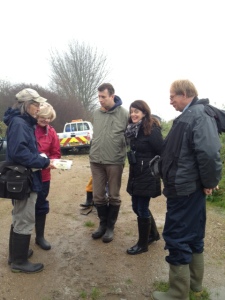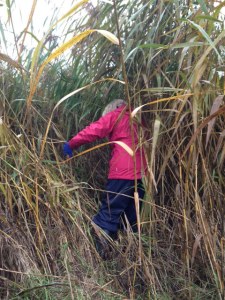The Harvest Mouse nest hunts at Crossness on 12th and 26th November have failed to find unequivocal evidence that Britain’s smallest rodent was present either on the northern part of the site, or southern marsh. Both had an example of what looked like it could possibly have been a disintegrated nest in a stand of Bramble, but the that fact no definite nests were found despite extensive searching by teams of several people, suggest that Thames Road Wetland (where several nests have appeared this year) , and Crayford Marshes to the north of there (a single record from 2007) may be the only locations in Bexley for this BAP species.

Chris Rose (Thames Road Wetland Site Manager) shows Crossness participants Ann, Paul, Donna and Mike a Harvest Mouse nest whilst discussing the plan of action. (Photo: Karen Sutton)

Ann disappears into a large stand of Common Reed during the unsuccessful quest to find Harvest Mouse nests at Crossness. (Photo: Karen Sutton)
A large woven structure of coarser material of about rugby ball size, and another of 15cm across at ground level, have been found at Crossness recently (the latter on the 26th), but these are thought to be above-ground Water Vole nests, made where there were unsuitable conditions for burrowing.
‘Negative records’ like this can, however, be valuable. The known locations suggest that the species may have existed along the marshes that once fringed the Thames in Bexley, and the Crossness habitat certainly looks very suitable. Consequently one might ask whether an introduction programme would be appropriate.
The most detailed historical records of mammals near Crossness that have been tracked down so far are for farmland around Lesnes Abbey Woods, dating from about 1920, but there is no mention of Harvest Mice. The occurrence of ‘one or two’ Hares, plus a few Red Squirrels in the woods themselves (both of which are now extinct in the Borough) as well as Stoats (described as ‘not uncommon’ – though also apparently gone from Bexley now) were, however, noted, and Rabbits were described as ‘fairly plentiful’ ………..
